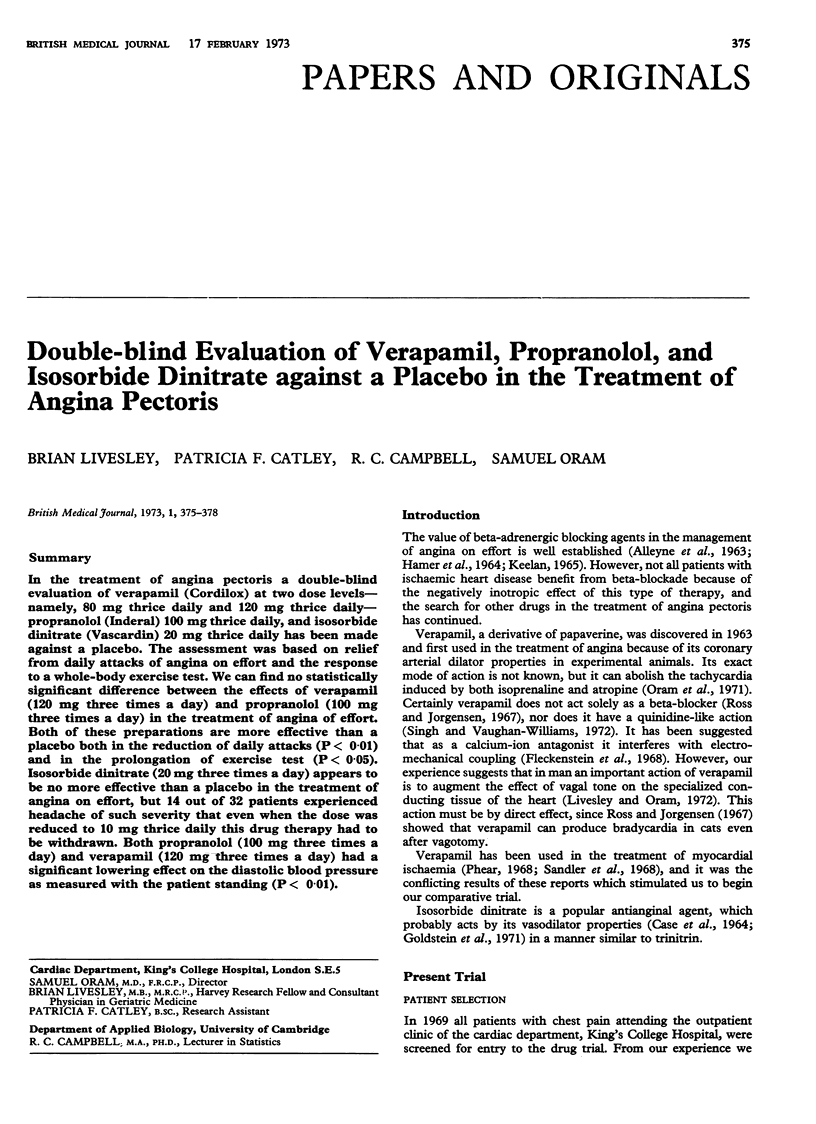Abstract
In the treatment of angina pectoris a double-blind evaluation of verapamil (Cordilox) at two dose levels—namely, 80 mg thrice daily and 120 mg thrice daily—propranolol (Inderal) 100 mg thrice daily, and isosorbide dinitrate (Vascardin) 20 mg thrice daily has been made against a placebo. The assessment was based on relief from daily attacks of angina on effort and the response to a whole-body exercise test. We can find no statistically significant difference between the effects of verapamil (120 mg three times a day) and propranolol (100 mg three times a day) in the treatment of angina of effort. Both of these preparations are more effective than a placebo both in the reduction of daily attacks (P < 0·01) and in the prolongation of exercise test (P < 0·05). Isosorbide dinitrate (20 mg three times a day) appears to be no more effective than a placebo in the treatment of angina on effort, but 14 out of 32 patients experienced headache of such severity that even when the dose was reduced to 10 mg thrice daily this drug therapy had to be withdrawn. Both propranolol (100 mg three times a day) and verapamil (120 mg three times a day) had a significant lowering effect on the diastolic blood pressure as measured with the patient standing (P < 0·01).
Full text
PDF



Selected References
These references are in PubMed. This may not be the complete list of references from this article.
- BELLET S., ELIAKIM M., DELIYIANNIS S., FIGALLO E. M. Radioelectrocardiographic changes during strenuous exercise in normal subjects. Circulation. 1962 Apr;25:686–694. doi: 10.1161/01.cir.25.4.686. [DOI] [PubMed] [Google Scholar]
- Balcon R., Hoy J., Malloy W., Sowton E. Haemodynamic comparisons of atrial pacing and exercise in patients with angina pectoris. Br Heart J. 1969 Mar;31(2):168–171. doi: 10.1136/hrt.31.2.168. [DOI] [PMC free article] [PubMed] [Google Scholar]
- Banks T., Shugoll G. I. Confirmatory physical findings in angina pectoris. JAMA. 1967 Jun 19;200(12):1031–1035. [PubMed] [Google Scholar]
- Bellet S., Muller O. F. The electrocardiogram during exercise. Its value in the diagnosis of angina pectoris. Circulation. 1965 Sep;32(3):477–487. doi: 10.1161/01.cir.32.3.477. [DOI] [PubMed] [Google Scholar]
- Fleckenstein A., Döring H. J., Kammermeier H. Einfluss von Beta-Receptorenblockern und verwandten Substanzen auf Erregung, Kontraktion und Energiestoffwechsel der Myokardfaser. Klin Wochenschr. 1968 Apr 1;46(7):343–351. doi: 10.1007/BF01734125. [DOI] [PubMed] [Google Scholar]
- Forrester J. S., Helfant R. H., Pasternac A., Amsterdam E. A., Most A. S., Kemp H. G., Gorlin R. Atrial pacing in coronary heart disease. Effect on hemodynamics, metabolism and coronary circulation. Am J Cardiol. 1971 Mar;27(3):237–243. doi: 10.1016/0002-9149(71)90296-7. [DOI] [PubMed] [Google Scholar]
- Gianelly R. E., Treister B. L., Harrison D. C. The effect of propranolol on exercise-induced ischemic S-T segment depression. Am J Cardiol. 1969 Aug;24(2):161–165. doi: 10.1016/0002-9149(69)90398-1. [DOI] [PubMed] [Google Scholar]
- Goldstein R. E., Rosing D. R., Redwood D. R., Beiser G. D., Epstein S. E. Clinical and circulatory effects of isosorbide dinitrate. Comparison with nitroglycerin. Circulation. 1971 May;43(5):629–640. doi: 10.1161/01.cir.43.5.629. [DOI] [PubMed] [Google Scholar]
- HAMER J., GRANDJEAN T., MELENDEZ L., SOWTON G. E. EFFECT OF PROPRANOLOL (INDERAL) IN ANGINA PECTORIS: PRELIMINARY REPORT. Br Med J. 1964 Sep 19;2(5411):720–723. doi: 10.1136/bmj.2.5411.720. [DOI] [PMC free article] [PubMed] [Google Scholar]
- HOLTER N. J. Radioelectrocardiography: a new technique for cardiovascular studies. Ann N Y Acad Sci. 1957 Aug 9;65(6):913–923. doi: 10.1111/j.1749-6632.1957.tb36693.x. [DOI] [PubMed] [Google Scholar]
- Livesley B., Oram S. Mode of action of verapamil in man. Br Med J. 1972 Apr 1;2(5804):50–50. doi: 10.1136/bmj.2.5804.50. [DOI] [PMC free article] [PubMed] [Google Scholar]
- Magel J. R., McArdle W. D., Glaser R. M. Telemetered heart rate response to selected competitive swimming events. J Appl Physiol. 1969 Jun;26(6):764–770. doi: 10.1152/jappl.1969.26.6.764. [DOI] [PubMed] [Google Scholar]
- Master A. M. The Master two-step test. Am Heart J. 1968 Jun;75(6):809–837. doi: 10.1016/0002-8703(68)90042-2. [DOI] [PubMed] [Google Scholar]
- Oram S., Catley P. F., Livesley B., Kidner P. H. An antidysrhythmic agent. Br Med J. 1971 Oct 9;4(5779):113–113. doi: 10.1136/bmj.4.5779.113-a. [DOI] [PMC free article] [PubMed] [Google Scholar]
- PRICHARD B. N., DICKINSON C. J., ALLEYNE G. A., HURST P., HILL I. D., ROSENHEIM M. L., LAURENCE D. R. EFFECT OF PRONETHALOL IN ANGINA PECTORIS. Br Med J. 1963 Nov 16;2(5367):1226–1229. doi: 10.1136/bmj.2.5367.1226. [DOI] [PMC free article] [PubMed] [Google Scholar]
- Phear D. N. Verapamil in angina: a double-blind trial. Br Med J. 1968 Jun 22;2(5607):740–741. doi: 10.1136/bmj.2.5607.740. [DOI] [PMC free article] [PubMed] [Google Scholar]
- ROSENFELD I., MASTER A. M., ROSENFELD C. RECORDING THE ELECTROCARDIOGRAM DURING THE PERFORMANCE OF THE MASTER TWO-STEP TEST. I. Circulation. 1964 Feb;29:204–211. doi: 10.1161/01.cir.29.2.204. [DOI] [PubMed] [Google Scholar]
- Ross G., Jorgensen C. R. Cardiovascular actions of iproveratril. J Pharmacol Exp Ther. 1967 Dec;158(3):504–509. [PubMed] [Google Scholar]
- Sandler G., Clayton G. A., Thornicroft S. G. Clinical evaluation of verapamil in angina pectoris. Br Med J. 1968 Jul 27;3(5612):224–227. doi: 10.1136/bmj.3.5612.224. [DOI] [PMC free article] [PubMed] [Google Scholar]
- WOOD P., McGREGOR M., MAGIDSON O., WHITTAKER W. The effort test in angina pectoris. Br Heart J. 1950 Oct;12(4):363–371. doi: 10.1136/hrt.12.4.363. [DOI] [PMC free article] [PubMed] [Google Scholar]


